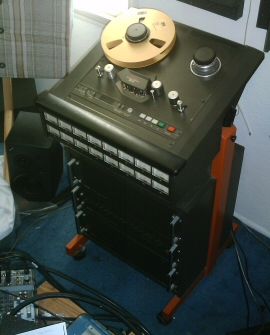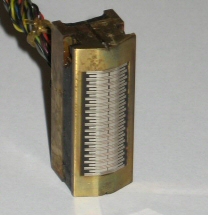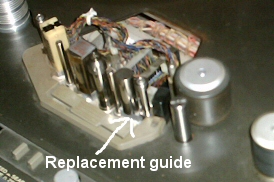The TASCAM 85-16 (8516 and
85-16B)
Last updated 07/08/2010
(clarified and
expanded)
There are a fair number of TASCAM 85-16 owners out there but seemingly very little info on the internet about it. To start, the 85-16 is a 16-track record/reproduce deck which utilizes 1 inch tape at 15 I/S (IPS or inches per second). The deck uses solid state logic to control all functions. It stands a little under 1.1 meters (4 feet) tall and weights 94.8KG (209lbs) without noise reduction. It was one of the first production model 1 inch 16-tracks and is THE first of its kind which had class-A discreet amplifiers using Field Effect Transistors in the front ends. This means no crossover distortion cutting into the ambience captured by the tape and instead of overloading suddenly like many IC based circuits, it saturates very smoothly like the tape itself. It uses the IEC standard EQ alignment which allows more headroom, less perceived noise and less phase shift than the traditional NAB standard which is more common for multi-track tape machines used in the United States. They were manufactured from about 1979 to 1984. MSRP was $10,500 USD with the DBX noise reduction unit which would be about $32,000 today.
The 85-16 doesn't look very impressive on paper, however the factory specifications don't do it justice. In reality, a well tuned 85-16 will exceed the factory specs marginally. The factory states 40Hz to 18KHz +-3dB using Quantegy 456. In reality, it will yield a frequency response of 30Hz to 19.3KHz +2dB, -1dB with DBX engaged using 499 and (probably 456 as well). The response is significantly wider without DBX. Compared to digital, this sounds like a large variance in frequency response. However, this is mostly caused by the resonance of the playback head which occurs at 60Hz. In actuality, this +2dB head bump is quite useful and actually allow the user (in a rock recording situation) to use less EQ in post production. The head bump is caused by magnetic fringing. That is to say that low frequencies create a sort of halo around the heads that gets printed onto the space between tracks. The lower the frequency, the greater the fringe effect is. On playback, this electromagnetic fringe is induced into the playback head, thus creating greater power at extremely low frequencies. This of course reaches a peak and then starts to drop as the frequency drops below the limits of what the head can reproduce. This sounds backwards but almost all rock music engineers boost 60Hz on bass drums and often even electric bass. Since the head bump is about +2dB at 60Hz, the need for such EQ is reduced or eliminated. Other common instruments do not contain much energy at this level and are thus not adversely affected by it. Furthermore, since the high frequency response rolls off smoothly and naturally, musical information can be tracked past 21KHz or beyond 30KHz without DBX.

The signal to noise ratio is (C-weighting) 65dB-68dB without noise reduction and 95dB-98dB with DBX depending on the reference levels and tape stock used. More about noise... With digital recording, the noise floor also defines the dynamic range. Using an excellent 16-bit storage system with good convertors, 93dB is the best possible signal to noise ratio. Below -96dB, there is NO information at all. There is actually theoretically no noise at all but details in the sound which occur at a lesser level than this are quantized into either a higher or lower level which turns into a constant distortion we perceive as noise. In the analogue world, the noise is an additive effect. That is, the noise really is noise and not the result of information being lost. In fact, detail can be perceived 20dB or so below the noise floor giving a total dynamic range closer to that of 113dB! Now a 24-bit system can theoretically resolve 144dB of total dynamic range. Jitter introduced by poor clocks, phase locked loops and shielding often used in lower/middle of the line convertors severely limit the usable dynamic range to 110dB-120dB. Many lower quality professional sound cards actually have lower than 16-bit performance even with 24-bit converters. Never the less, the average guitar amp generates far more noise than the tape will. Many times, even room noise is greater than tape noise even without noise reduction. Bear in mind that contrary to popular belief, most of the measured noise on tape is in the extremely low frequencies. Though this noise is not noticeable and in fact, most speaker systems cannot even reproduce this noise so perceived noise is actually lower than the measured noise.
The optional features of the 85-16 also add greatly to the value of such machine. Even though the 85-16 is much quieter than most computers with their whirring fans and hard drives, the remote control allows the unit to be operated in a closet space further reducing noise. The remote cable can be long enough to control the system from an entirely different room if one so chooses. The remote is two standard 19 inch rack spaces and includes record arm functions, auto-locate as well as transport functions. The remote is in fact simply the built-in transport control moved to another location through the use of a longer cable. An additional record arm/disarm is often added to make up the complete remote taking two rack spaces. The 85-16 also includes a pulse sync output from the capstan motor allowing several tape machines to be synchronized directly off of a single master unit. This can be done without losing a track to time code. However, the sync is relative and the tapes must be queued manually. A drumstick clack, audio slate or pulse tone before the beginning of each song is a good reference point. Never the less, synchronizing two units with nothing other than a special cable is a great advantage. Similarly, since the DBX is switched manually on a track by track basis, a single track can be set up to record SMPTE time code to one track for the purpose of synchronizing video/film or other audio equipment not compatible with the sync output from the deck. Automation of an analogue or digital mixing board can also be used with the integration of SMPTE time code. The ability to disable any individual DBX channel also allows the engineer to use noise reduction only on tracks where it's required. The crystal sync for the capstan motor can be disengaged to allow a +-10% shift in record/playback speed which is handy for making recording easier or for special effects. The pulse code is taken directly off of the capstan so applying a pitch shift will also effect other devices connected to the 85-16.

The overall construction is quite rugged and reliable and one can expect their 25-year plus machines to outlive most any modern equipment, particularly DAWs. Many people have pointed out the idea that the 85-16 is not a serious studio machine. Even though there is better equipment than this middle of the line analogue 16-track, it still beats almost all other options in subjective sound quality, longevity and operational ergonomics. This little workhorse sounds better than the supposedly more serious MCI 2 inch decks in many people's opinions and is certainly cheaper to operate. It's the perfect solution for mid-level studios who don't want to be forced into computer based DAWs without spending the cash on 2 inch tape. At any rate, with an original price tag similar to that of a new car, it was still a serious commitment for any studio owner.
The original orange legs of the 85-16, the result of a miscommunication with the marketing department, won it the name Flamingo. This was fixed in the 85-16B. The 85-16B is nearly identical to the original with the exception of the color and slightly more flexible internal signal routing. Additionally, the 16B sports a redesigned capstan servo amp which reduces flutter. The original capstan amp had a tendency to overcompensate for slight variations in speed.
The setup requirements should be as follows. For Ampex/Quantegy 456 or similar, operating level should be 250nW/m with about +3dB overbias at 10KHz. For Quantegy 499 or similar, the operating level should be around 400nW/m +4dB overbias. These are approximate settings and all final adjustments should be done by ear to minimize distortion at nominal levels. If you are using noise reduction, there is no need to go above these levels as the noise floor should be sufficiently low. Recording hotter signals will simply take away the transient response of the signal making for less clarity on tape. If you wish to disable the noise reduction, you may record at 370nW/m for 456 and 520nW/m for 499/GP9. However, this will eat into your headroom quite a bit. Some people may comment that this deck is not well suited for newer stocks like 499 and GP9 or the new ATR tape but this is not the case. The motors are more than able to handle the thicker oxide and the electronics have sufficient headroom to handle the extra load. When properly calibrated and aligned, any tape used on this deck will saturate before the electronics will. Even ATR which is meant to run hotter than any of these listed stocks will saturate before the internal electronics of the machine.
In order for the DBX noise reduction to work at its optimal performance, the deck must be aligned within .5dB of its intended operating levels. Failure to match these tolerances can make for either a compressed or expanded sound on playback. Beware that running the levels too high to tape will prevent the signal from being fully decoded on playback, also causing a compressed sound. The user manual has no instructions on aligning the DBX unit. However, it needs to be done as regularly as the deck itself. Electronic adjustment is a fairly straight forward procedure. Align for playback and record of the deck without DBX in the normal fashion. Once record and playback alignment is correct, play pink noise through the deck at 0dBVU on all tracks. Engage the DBX and adjust the DBX encode level pot (R105) till the VU meter of each track reads 0dB. Record the noise for a few minutes on all tracks once the encoded level is adjusted. Rewind to the beginning of the section of noise which has the proper recorded levels. Play back the noise, watching the levels for each channel on an external VU meter such as on a recording console or another tape deck. Do not use peak meters of any kind as they will deceive you. Adjust the playback trim pot (R104) till the playback levels are the same on the external device with and without DBX. Unlike the amplifier cards which have the trim pots on the front, is impossible to adjust the trim pots of the DBX cards without an extension card as the pots are on the side. Fortunately, the DBX cards are the same as that used on the Teac 80-8 so spares are readily available if needed. Unfortunately it looks as though the 85-16B uses a slightly different card and it is uncertain as to whether the cards are interchangeable but the extension card SHOULD be the same.
Finally, many people ask if their tape heads are in good shape
or not. In short, they should be smooth and rounded where the tape
contacts them. Run your fingernails over the heads and make sure there's no
obvious notches or scratches. If the heads have flat spots or uneven wear,
they require a relap. Relaping refers to grinding down offending portions
of the head and polishing them so that they are smooth and well rounded.
If there aren't already relief notches ground in the outer edges of the heads,
these are added also. Furthermore, one should not see the head gaps like
in the image to the right. Those black marks in the middle of the head are
the head gaps. If these are exposed, they will get wider and wider over
time, interfering with bias and frequency response. Worn heads will also
damage the tape so don't use a deck with bad heads. Heads like that belong
in the trash and nowhere else.
Run your fingernails over the heads and make sure there's no
obvious notches or scratches. If the heads have flat spots or uneven wear,
they require a relap. Relaping refers to grinding down offending portions
of the head and polishing them so that they are smooth and well rounded.
If there aren't already relief notches ground in the outer edges of the heads,
these are added also. Furthermore, one should not see the head gaps like
in the image to the right. Those black marks in the middle of the head are
the head gaps. If these are exposed, they will get wider and wider over
time, interfering with bias and frequency response. Worn heads will also
damage the tape so don't use a deck with bad heads. Heads like that belong
in the trash and nowhere else.
I've heard of these machines being modified to run at different speeds or even switch selectable speeds such as 7.5 I/S-15 I/S or 15 I/S-30 I/S. I do not know how to do this and would not recommend making such modification. Operating this machine at 7.5 IPS will double the record time of your tape but at the expense of high frequency loss. It would also require higher levels of bias which will degrade the signal quality due to intermodulation. Running the 85-16 at 30 I/S will smooth out the noise making it less intrusive for those not using DBX and will extend the HF response. In turn, you will loose the bottom octave of your music and the head bump will be raised to a more intrusive 120Hz or so.

Since replacement heads are expensive, it is easy to machine a tape guide to take the place of the less necessary monitor head. This head is identical to the record head and the monitor head is only really necessary to calibrate the bias. Therefore you can save the wear and tear on this head and keep it primarily as a spare. Later on in your head's lives, you can trade the more worn record/repro head with the monitor head and use the other only when needed for realignment.
Another common mod is to replace the record and repro heads with higher quality ones, preferably with a record optimized head and the other optimized for reproducdtion to reduce fringing and lower resonant frequency. By mixing from the monitor head, the head bump is thereby reduced at the cost of some extreme low frequency reproduction. Also, using a record head with a .5 mil head gap reduces the need for overbias by about 3dB which means cleaner high end.
The shielding in the 85-16 isn't the best so the capstan motor creates interference which is picked up by the output amplifiers. It is possible to add additional shielding particularly around the head block which will reduce the mechanical noise.
The relays in the DBX unit are unsealed mechanical types which are best replaced with solid state relays. This will greatly increase the reliability and quality as well as extend the life of the unit. Though DBX claims maintenance is not needed on these modules, any 85-16 owner will tell you the DBX causes more problems than any other part of the deck mostly because of these relays.
While the electronics are surprisingly good in the amplifier circuits themselves it is possible to replace them with more advanced quieter electronics. Though this is an expensive process it can extend the signal to noise ratio and the resolving capabilities of the recording.
If anybody has suggestions on information that should be included in this article, please E-mail the author.
Due to spam, a graphic is used for the E-mail address instead of a mouse click to instantly gain access. Just type what you see in the image below into another window. Sorry for the inconvenience.
